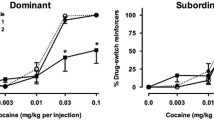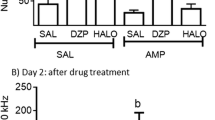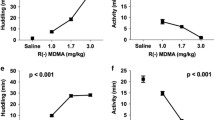Abstract
Psychostimulants lead to withdrawal from social interactions and to a decline of affective behavior in squirrel monkeys. These changes, in addition to motor stereotypies, may be related to stimulant-induced psychosis in humans. In the first of two series of experiments, 1 mg/kg d-amphetamine or 10 mg/kg cocaine, administered orally three times over 24 h to one adult male member of an established group (n=6–9), engendered stereotyped movements of the head and hands, reduced rest postures, and greatly reduced all forms of social initiatives. Chlorpromazine (0.25–1.0 mg/kg), haloperidol (0.25, 0.5 mg/kg), and physostigmine (0.04, 0.08 mg/kg), administered before the third amphetamine or cocaine injection, blocked the motor stereotypies and hyperactivity. Chlorpromazine, haloperidol, and physostigmine did not reliably antagonize the pronounced reduction in social behavior. The second series of experiments focused on agonistic behavior in the context of resident-intruder confrontations and on affiliative behavior toward group members. d-Amphetamine (3×0.5 mg/kg) and, to a lesser extent, cocaine (3×10 mg/kg) decreased affiliative and agonistic behavior. Chlorpromazine (0.5, 1.0 mg/kg) and haloperidol (0.1, 0.25 mg/kg) did not block the severe disruption of the affiliative and agonistic behavior in amphetamine-treated monkeys; physostigmine (0.06 mg/kg) reversed the decline in time spent close to the familiar monkey in amphetamine-treated monkeys. By contrast, stimulant-induced stereotypies were effectively antagonized by chlorpromazine, haloperidol, and physostigmine. These results suggest that psychostimulant-induced changes in primate social behavior may be mediated by mechanisms other than those underlying motor stereotypies.
Similar content being viewed by others
References
Altmann J (1974) Observational study of behavior: sampling methods. Behaviour 49:227–267
Angrist B, Lee HK, Gershon S (1974) The antagonism of amphetamine-induced symptomatology by a neuroleptic. J Psychiatry 131:817–819
Bell DS (1965) Comparison of amphetamine psychosis and schizophrenia. Br J Psychiatry 111:701–707
Carlsson A (1978) Antipsychotic drugs, neurotransmitters, and schizophrenia. Am J Psychiatry 136:164–175
Crowley TJ, Stynes AJ, Hydinger M, Kaufman TC (1974) Ethanol, methamphetamine, pentobarbital, morphine, and monkey social behavior. Arch Gen Psychiatry 31:829–838
Davis KL, Hollister LE, Tepper J (1978) Cholinergic inhibition of methylphenidate-induced stereotypy: oxotremorine. Psychopharmacology 56:1–4
Ellinwood EH, Kilbey MM (eds) (1977) Cocaine and other stimulants. Plenum Press, New York
Espelin DE, Done AK (1968) Amphetamine poisoning: Effectiveness of chlorpromazine. New Engl J Med 278:1361–1365
Garver DL, Schlemmer RF Jr, Maas JW, Davis JM (1975) A schizophreniform behavioral psychosis mediated by dopamine. Am J Psychiatry 132:33–38
Griffith JD, Davanaugh JH, Held J, Oates JA (1970) Experimental psychosis induced by the administration of d-amphetamine. In: Costa E, Garattini S (eds) Amphetamines and related compounds. Raven Press, New York, pp 897–904
Haber S, Barchas PR, Barchas JD (1977) Effects of amphetamine on social behavior of rhesus macaques: An animal model of paranoia. In: Hanin I, Usdin E (eds) Animal models in psychiatry and neurology. Pergamon Press, New York, pp 107–115
Hopf S, Hartmann-Wiesner E, Kühlmorgen B, Mayer S (1974) The behavioral repertoire of the squirrel monkey (Saimiri) Folia Primatol 21:225–249
Hornykiewicz O (1978) Psychopharmacological implications of dopamine and dopamine antagonists: A critical evaluation of current evidence. Neuroscience 3:773–783
Janowsky DC, El-Yousef MK, Davis JM, Sekerke HJ (1972) Cholinergic antagonism of methylphenidate-induced stereotyped behavior. Psychopharmacologia 27:295–303
Machiyama Y, Utena H, Kikuchi M (1970) Behavioral disorders in Japanese monkeys produced by the long-term administration of methamphetamine. Proc Jap Acad 46:738–743
Machiyama Y, Hsu SC, Utena H, Katagiri M, Hirata A (1974) Aberrant social behavior induced in monkeys by the chronic methamphetamine administration as a model for schizophrenia. In: Mitsuda H, Fukuda T (eds) Biological mechanisms of schizophrenia and schizophrenia-like psychoses. Igaku Shoin Ltd, Tokyo, pp 97–105
Mason WA (1975) Comparative studies of social behavior in Callicebus and Saimiri: Strength and specificity of attraction between male-female cagemates. Folia Primatol 23:113–123
Miczek KA (1978) 170-1: Antiaggressive effects in mice, rats and squirrel monkeys. Science 199:1459–1461
Miczek KA, Krsiak M (1979) Drug effects on agonistic behavior. In: Thompson T, Dews PB (eds) Advances in behavioral pharmacology, vol 2. Academic Press, New York, pp 87–162
Miczek KA, Krsiak M (1981) Pharmacological analysis of attack and flight. In: Brain PF, Benton D (eds) A multidisciplinary approach to aggression research. Elsevier, Amsterdam, pp 341–354
Miczek KA, Woolley J, Schlisserman S, Yoshimura H (1981) Analysis of amphetamine effects on agonistic and affiliative behavior in squirrel monkeys (Saimiri sciureus). Pharmacol Biochem Behav. Suppl 1, 14:103–107
Poignant JC, Avril A (1978) Pharmacological studies on drugs acting on social behaviour of squirrel monkey — effects of amineptine, piribedil, d-amphetamine and amitriptyline. Arzneim Forsch 28:267–271
Post RM (1975) Cocaine psychoses: A continuum model. Am J Psychiatry 132:225–231
Randrup A, Munkvad I (1967) Stereotyped activities produced by amphetamine in several animal species and man. Psychopharmacologia 11:300–310
Rosenblum LA, Levy E, Kaufman IC (1968) Social behaviour of squirrel monkeys and the reaction to strangers. Anim Behav 16:288–293
Schiørring E (1977) Changes in individual and social behavior induced by amphetamine and related compounds in monkeys and man. In: Ellinwood EH, Kilbey M (eds) Cocaine and other stimulants. Plenum Press, New York, pp 481–522
Schiørring E (1981) Psychopathology induced by “speed-drugs”. Pharmacol Biochem Behav Suppl 1, 14:109–122
Schiørring E, Hecht A (1979) Behavioral effects of low, acute doses of d-amphetamine on the dyadic interaction between mother and infant vervet monkeys (Cercopithecus aethiops) during the first six postnatal months. Psychopharmacology 64:219–224
Scraggs PR, Ridley RM (1979) The effect of copamine and noradrenaline blockade on amphetamine-induced behaviour in the marmoset. Psychopharmacology 62:41–45
Siegel S (1956) Nonparametric statistics for the behavioral sciences. McGraw-Hill, New York
Snyder SH (1973) Amphetamine psychosis: A “model” schizophrenia mediated by catecholamines. Am J Psychiatry 130:61–67
Utena H, Machiyama Y, Hsu SC, Katagiri M, Hirata A (1975) A monkey model for schizophrenia produced by methamphetamine. Contemporary Primatology. Karger, Basel, pp 502–507
Van Dyke C, Byck R (1977) Cocaine: 1884–1974. In: Ellinwood EH Jr, Kilbey MM (eds) Cocaine and other stimulants. Plenum Press, New York, pp 1–30
Wallach MB (1974) Drug-induced stereotyped behavior:Similarities and differences. In: Usdin E (ed) Neuropsychopharmacology of monamines and their regulatory enzymes. Raven Press, New York, pp 241–260
Author information
Authors and Affiliations
Rights and permissions
About this article
Cite this article
Miczek, K.A., Yoshimura, H. Disruption of primate social behavior by d-amphetamine and cocaine: Differential antagonism by antipsychotics. Psychopharmacology 76, 163–171 (1982). https://doi.org/10.1007/BF00435272
Received:
Accepted:
Issue Date:
DOI: https://doi.org/10.1007/BF00435272




